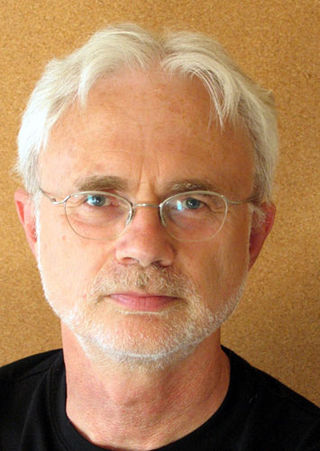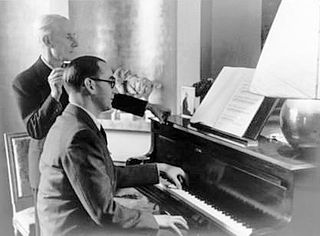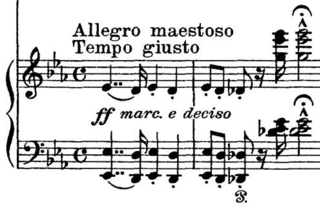Related Research Articles

John Coolidge Adams is an American composer and conductor whose music is rooted in minimalism. Among the most regularly performed composers of contemporary classical music, he is particularly noted for his operas, which are often centered around recent historical events. Apart from opera, his oeuvre includes orchestral, concertante, vocal, choral, chamber, electroacoustic and piano music.
Sonata form is a musical structure generally consisting of three main sections: an exposition, a development, and a recapitulation. It has been used widely since the middle of the 18th century.

Short Ride in a Fast Machine is a 1986 orchestral work by John Adams. Adams applies the description "fanfare for orchestra" to this work and to the earlier Tromba Lontana (1986). The former is also known as Fanfare for Great Woods because it was commissioned for the Great Woods Festival of the Pittsburgh Symphony Orchestra.
In music, variation is a formal technique where material is repeated in an altered form. The changes may involve melody, rhythm, harmony, counterpoint, timbre, orchestration or any combination of these.
The Desert Music is a work of music for voices and orchestra composed by the minimalist composer Steve Reich. It is based on texts by William Carlos Williams and takes its title from the poetry anthology The Desert Music and Other Poems. The composition consists of five movements, with a duration of about 46 minutes. In both its arrangement of thematic material and use of tempi, the piece is in a characteristic arch form (ABCBA). The piece was composed in 1983 and had its world premiere on 17 March 1984 in Cologne, Germany.

The Piano Concerto for the Left Hand in D major was composed by Maurice Ravel between 1929 and 1930, concurrently with his Piano Concerto in G major. It was commissioned by the Austrian pianist Paul Wittgenstein, who lost his right arm during World War I. The Concerto had its premiere on 5 January 1932, with Wittgenstein as soloist performing with the Vienna Symphony Orchestra.

Franz Liszt composed his Piano Concerto No. 1 in E♭ major, S.124 over a 26-year period; the main themes date from 1830, while the final version is dated 1849. The concerto consists of four movements and lasts approximately 20 minutes. It premiered in Weimar on February 17, 1855, with Liszt at the piano and Hector Berlioz conducting.
Shaker Loops is a 1978 composition by American composer John Adams, originally written for string septet. The original "modular" score, published by Associated Music Publisher, has since been withdrawn and replaced by a 1983 string orchestra version. This version was first performed in April of that year at Alice Tully Hall, New York, by the American Composers Orchestra, conducted by Michael Tilson Thomas. The string orchestra version can be played either by a septet of soloists or by a string orchestra of any size, where the violins are divided into 3 parts throughout.
Harmonielehre is a forty-minute orchestral composition by the American composer John Adams, composed in 1985. In his memoir, Adams stated that the piece "was a statement of belief in the power of tonality at a time when I was uncertain about its future" and that it was "a one-of-kind [sic] once-only essay in the wedding of fin-de-siècle chromatic harmony with the rhythmic and formal procedures of Minimalism".
The Introduction and Rondo Capriccioso in A minor, Op. 28, is a composition for violin and orchestra written in 1863 by Camille Saint-Saëns. It was dedicated to the virtuoso violinist Pablo de Sarasate, who performed the solo violin part at the premiere in April 1867.

The Symphony No. 4 in A minor, Op. 63, is one of seven completed symphonies composed by Jean Sibelius. Written between 1910 and 1911, it was premiered in Helsinki on 3 April 1911 by the Philharmonia Society, with Sibelius conducting.
American Berserk is a short composition for solo piano by the American composer John Adams. The work was commissioned by the Carnegie Hall Corporation for the pianist Garrick Ohlsson, to whom the piece is dedicated. The first performance took place on February 25, 2002, at Carnegie Hall, New York City, with Ohlsson on the piano.
The Symphony No. 1 in B♭ minor is one of two symphonies by the English composer William Walton. The composer had difficulty in completing the work, and its first public performance was given without the finale, in 1934. The complete four-movement work was premiered the following year.
Naive and Sentimental Music is a symphonic work by American composer John Adams. The title of the work alludes to an essay by Friedrich Schiller, On Naïve and Sentimental Poetry, that contrasts a creative personality that creates art for its own sake versus one conscious of other purposes, such as art’s place in history. The composer cites both the slowly developing harmonies of Bruckner's Fourth Symphony and the atmosphere of the Sonoma coastline as inspirations for the work. The piece was co-commissioned by the Los Angeles Philharmonic, the Ensemble Modern, the Vancouver Symphony Orchestra, and the Sydney Symphony Orchestra. It received its first public performance by the Los Angeles Philharmonic conducted by Esa-Pekka Salonen on February 19, 1999. A recording by Salonen and the Los Angeles Philharmonic was subsequently released by Nonesuch Records.
New York Counterpoint for amplified clarinet and tape, or 9 clarinets and 3 bass clarinets, is a 1985 minimalist composition written by American composer Steve Reich. The piece, intended to capture the throbbing vibrancy of Manhattan, is notable for its ability to imitate electronic sounds through acoustic instrumentation.

Chamber Symphony is a 1992 composition for a 15-member chamber orchestra by American composer John Adams, inspired by Arnold Schoenberg's Chamber Symphony No. 1, Op. 9. It is a three-movement work that takes about 23 minutes to perform.
The Icarian Rhapsody is a single-movement composition for string orchestra by the American composer Mason Bates. It was composed in 1999 and was first performed November 14, 2003 by the Oakland East Bay Symphony under conductor Michael Morgan.
Absolute Jest is a concerto for string quartet and orchestra by the American composer John Adams. The work was commissioned by the San Francisco Symphony for the orchestra's centennial. Its world premiere was given at the Louise M. Davies Symphony Hall on March 15, 2012, and was performed by the St. Lawrence String Quartet and the San Francisco Symphony under the direction of Michael Tilson Thomas. However, after the premiere Adams heavily re-wrote the beginning of the piece; this revised version of Absolute Jest was first performed in Miami Beach on December 1, 2012, by the St. Lawrence String Quartet and the New World Symphony under the composer's direction.
The Symphony No. 2, or 'Cello Symphony is a composition for orchestra by the American composer Ellen Taaffe Zwilich. The work was composed in 1985 on a commission from the San Francisco Symphony. It was first performed on November 13, 1985, by the San Francisco Symphony under the direction of Edo de Waart, to whom the piece is dedicated.
Her Story is a composition for 10 women's voices and orchestra by the American composer Julia Wolfe. The work was commissioned by a consortium of orchestras including the Boston Symphony Orchestra, Chicago Symphony Orchestra, Nashville Symphony, National Symphony Orchestra, and San Francisco Symphony. Its world premiere was performed by the Nashville Symphony and Lorelei Ensemble conducted by Giancarlo Guerrero at the Schermerhorn Symphony Center on September 15, 2022.
References
- ↑ Barone, Joshua (April 16, 2021). "A Battle of Boos and Cheers at the Symphony". The New York Times. ISSN 0362-4331 . Retrieved September 6, 2023.
- ↑ May, Thomas (2006). The John Adams Reader: Essential Writings on an American Composer. Pompton Plains, N.J.: Amadeus. p. 90. ISBN 1574671324. OCLC 67872729.
- ↑ Service, Tom (September 4, 2012). "A Guide to John Adams's Music". The Guardian . Retrieved June 7, 2018.
- ↑ "Adams' 'Grand Pinanola [sic] Music' Debuts in Louisville". Louisville. January 7, 2009. Archived from the original on June 12, 2018. Retrieved June 7, 2018.
- ↑ Cook, Karen M. (2014). "Music, History, and Progress in Sid Meier's Civilization IV". In Donnelly, K. J.; Gibbons, William; Lerner, Neil (eds.). Music in Video Games: Studying Play. New York: Routledge. ISBN 978-1-315-88269-7.
- ↑ "LSO Half Six Fix: John Adams' Harmonielehre". lso.shorthandstories.com. Retrieved September 5, 2023.